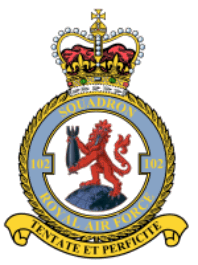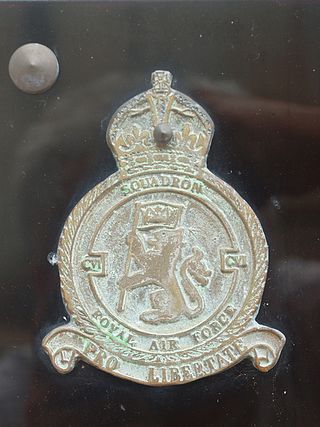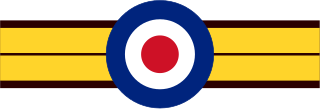
No. 220 Squadron of the Royal Air Force (RAF) was founded in 1918 and disbanded in 1963 after four separate periods of service. The squadron saw service in both the First and Second World Wars, as a maritime patrol unit, and finally as part of Britain's strategic nuclear deterrent.
No. 635 Squadron RAF was a heavy bomber squadron of the Royal Air Force during the Second World War.
No. 515 Squadron RAF was a squadron of the Royal Air Force formed during the Second World War. It ushered in Electronic countermeasures (ECM) warfare, jamming enemy radar installations from October 1942 as the only such squadron in the RAF initially. Later in the war 515 Sqn was joined by other squadrons as part of No. 100 Group RAF. The squadron disbanded after VE day, when the need for such a specialised squadron had reduced.

No. 102 Squadron was a Royal Air Force night bomber squadron in the First World War and a heavy bomber squadron in the Second World War. After the war it flew briefly as a transport squadron before being reformed a light bomber unit with the Second Tactical Air Force within RAF Germany. Its last existence was as a Thor strategic missile unit.
No. 215 Squadron RAF was a Royal Air Force aircraft squadron formed as a night bomber squadron in the First and Second World Wars, becoming a transport squadron near the end of the Second World War.
No. 353 Squadron RAF was a Royal Air Force squadron, active during World War II carrying out maritime patrol and transport tasks.

No. 97 Squadron, was a Royal Air Force squadron formed on 1 December 1917 at Waddington, Lincolnshire.

No. 106 Squadron RAF was a Royal Flying Corps and Royal Air Force squadron active from 1917 until 1919, throughout World War II and during the Cold War from 1959 until 1963.
No. 113 Squadron began service in 1917 with the Egyptian Expeditionary Force commanded by General Edmund Allenby. Initially, the squadron was a unit of the Royal Flying Corps, serving during the Sinai and Palestine Campaign and as a reconnaissance, army cooperation, bomber, fighter, transport and missile operation squadron during its existence.

No. 264 Squadron RAF, also known as No. 264 Squadron, was a squadron of the Royal Air Force.
No. 104 Squadron RAF is a former squadron of the British Royal Air Force.

No. 239 Squadron RAF was an anti-submarine squadron of the Royal Air Force during World War I. During World War II the squadron performed as an army co-operation squadron and later as a night intruder unit. After the war the squadron was disbanded.
No. 77 Squadron RAF was a squadron of the Royal Air Force which was active in various incarnations between 1916 and 1963.
Royal Air Force Catfoss, or more simply RAF Catfoss, is a former Royal Air Force station during the Second World War. It was located 4 miles (6.4 km) west of Hornsea, Yorkshire, England and 8 miles (13 km) north-east of Leconfield, Yorkshire, with the nearest village being Brandesburton.
No. 82 Squadron RAF was a Royal Air Force squadron that was first formed in 1917 and last disbanded in 1963. It served at times as a bomber unit, a reconnaissance unit and lastly as an Intermediate Range Ballistic Missile (IRBM) unit.
No. 107 Squadron RAF was a Royal Flying Corps bomber unit formed during the First World War. It was reformed in the Royal Air Force during the Second World War and was operational during the Cold War on Thor Intermediate Range Ballistic Missiles.

No. 142 Squadron was a flying squadron of the Royal Air Force (RAF). It was formed at RFC Ismailia in Egypt during the First World War. Disbanded in 1920, then re-formed in 1934, 142 Squadron in France, then over occupied Western Europe. In 1942, it was transferred to North Africa where it took part in the North African and Italian campaigns. After the war, it was transformed into a Strategic Missile being eventually disbanded in 1963.
No. 240 Squadron RAF was a Royal Air Force flying boat and seaplane squadron during World War I, World War II and up to 1959. It was then reformed as a strategic missile squadron, serving thus till 1963.

No. 130 Squadron of the Royal Air Force was a Second World War and Cold war fighter squadron, and later a strategic missile squadron.
Royal Air Force Witchford, or more simply RAF Witchford, is a former Royal Air Force Royal Air Force sub-station about 2 miles (3 km) southwest of Ely, Cambridgeshire, England and 13 miles (21 km) north of Cambridge, Cambridgeshire.








